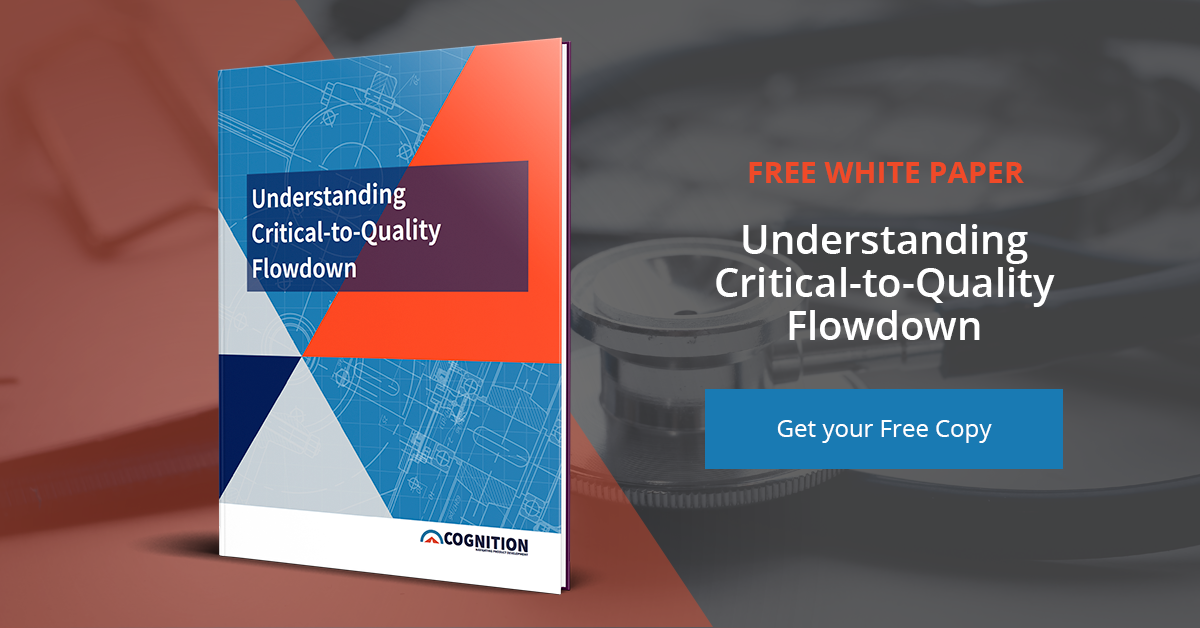How to Write Effective CTQs for Your Life Science Product
Implementing a critical-to-quality (CTQ) program in your life science organization’s product development process can be a valuable effort. Identifying CTQ requirements and working through both CTQ Flowdown and Flowup activities can lead to more robust, well-made products that meet your user needs.
But how do you know if a CTQ requirement is effective? By making them understandable, verifiable, and attainable.
Understandable
 When coming up with CTQ requirements, it is important to verify their purpose and parameters are clear and consistent. Any space left for interpretation via ambiguous language, unclear targets, etc. can cause a host of issues. When, for example, a CTQ could apply to more than one design aspect or the thresholds for success are vague, this opens up a lot of room for error.
When coming up with CTQ requirements, it is important to verify their purpose and parameters are clear and consistent. Any space left for interpretation via ambiguous language, unclear targets, etc. can cause a host of issues. When, for example, a CTQ could apply to more than one design aspect or the thresholds for success are vague, this opens up a lot of room for error.
This can result in the CTQ being improperly developed or additional work. Therefore, it’s important to make sure your requirements are clearly stated, address one thing with simple interpretation, and don’t contradict other requirements. Otherwise, the threshold for confusion in later-stage development lowers, and could result in remediation or other adverse effects.
Verifiable
Unclear requirements are also troublesome because they aren’t verifiable. The work involved in advancing a CTQ is lost if there’s no way to confirm whether it has been satisfied. To empower CTQ verification, there are three methods your team can leverage:
- Specific testing such as biocompatibility, usability, software, sterility, etc.
- Material, chemical, hazard, failure, procedure/process analyses (among others)
- Inspections such as design reviews
 These verification activities are beneficial throughout a product’s life cycle. During development, the resulting measurements can quickly establish why particular CTQs may not be passing regular tests and inspections. Before the product ever gets to market, your team has a chance to readjust larger issues and control design risks that may not have been immediately apparent.
These verification activities are beneficial throughout a product’s life cycle. During development, the resulting measurements can quickly establish why particular CTQs may not be passing regular tests and inspections. Before the product ever gets to market, your team has a chance to readjust larger issues and control design risks that may not have been immediately apparent.
Likewise, verifiable CTQs resolve supply chain issues. Verification problems that occur after tech transfer to the supply chain often mean either the supplier is noncompliant, technology transfers were incomplete or insufficient, something in the product design is impacting verification/overall quality, or the CTQ’s verification requirements need adjustment. In the event verification requirements need adjustment, having verification measurements and requirements in place are diagnostic—they can help you easily and quickly spot problems before they get further compounded down the supply chain.
Attainable
Evaluating a CTQ with the notion in mind of attainability/feasibility helps you produce and alter the flowdown requirements in ways that satisfy the overall CTQ and associated user needs. To determine attainability, three specific factors are often at play: cost, time, and tech. Whether or not the cost to construct a requirement is feasible impacts your organization’s ability to realize it, as well as the time it takes to make it. Likewise, technical factors such as equipment, training, materials, and other resource considerations need to be accounted for when determining the attainability of a given CTQ.
Why Do CTQs Matter in Life Science Product Development?
CTQs are tied to user needs and identify features or characteristics of your product that are integral to satisfying those needs. They can be useful in cutting through the noise of all the data generated as the result of life science product development and in prioritizing your activities. Being able to identify how effective the CTQ is based on its understandability, verifiability, and attainability can streamline your development activities and optimize the product design to satisfy your users’ needs.
About Cognition Corporation
At Cognition, our goal is to provide medical device and pharmaceutical companies with collaborative solutions to the compliance problems they face every day, allowing the customer to focus on their products rather than the system used to create them. We know we are successful when our customers have seamlessly integrated a quality system, making day-to-day compliance effortless and freeing up resources to focus on product safety and efficacy.





